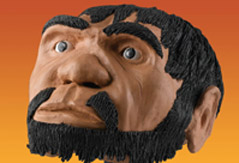Make Up “Makeover” for Neanderthals
Evidence of Body Painting and Neanderthal Jewellery Unearthed in Spain
The public perception of the Hominid species known as the Neanderthal is that of a thuggish, brute with more simian features than human. The origin of this impression lies deep in Victorian culture when the fossils of these ancient humans were first closely studied. The idea of another hominid species having sophisticated behaviour, advanced communication skills and the ability to think in abstract ways was seen as a anathema to Victorian values. After all, certain races of our own species H. sapiens were thought by Victorian scientists to be distinct and separate from the “white European” hominid.
Neanderthal
When anatomist William King published his work on the human remains found at the Neander valley site (Germany) and named this new species of human, one eminent German scientist refused to believe him and contended that the fossils were those of a Russian Cossack soldier who had been killed in the Napoleonic Wars. The deeply furrowed brow region of the skull was explained away as being changes in the skull morphology as this poor fellow frowned a great deal.
Given this rather biased scientific view and the fact that later remains of very old, arthritic individuals were studied the Neanderthal in public perception remains a stooped, hairy, ape-like beast. However, new research published in the scientific journal “The Proceedings of the National Academy of Sciences” indicates that our near cousins were sophisticated and capable of understanding symbolism.
A Sophisticated, Cultured Neanderthal?

Picture credit: Everything Dinosaur
This new evidence, unearthed by a team of scientists from Bristol University working in association with European colleagues, has been found at dig sites located in Murcia province, southern Spain. The researchers claim that these new finds will help to bury the outdated view of “Neanderthals as half-wits”. The team’s interpretation of the artefacts found, seashells that could have been used as pigment containers and other shells fashioned into jewellery, leads them to conclude that Neanderthals were capable of abstract, symbolic thinking.
Professor Joao Zilhao, an archaeologist from Bristol University (United Kingdom), and lead author of this study stated that he and hist team had examined shells that were used as containers to mix and store pigments.
Black sticks of the pigment manganese, which may have been used as body paint by Neanderthals, have previously been discovered in Africa. However, as Professor Zilhao commented:
“This is the first secure evidence for their [Neanderthal] use of cosmetics”. The use of these complex recipes is new. It’s more than body painting.”
The scientists found lumps of a yellow pigment, that they say was possibly used as a foundation. In addition, the team also found red powder mixed up with flecks of a reflective brilliant black mineral. A number of shells found at the two sites studied show signs of being worked, perhaps to create ornate objects that could be worn, just as modern humans wear jewellery.
One of the distinguishing characteristics of our own species from Neanderthals was our ability to use symbolism, to think in abstract terms and to develop strong community bonds via sophisticated rituals. These new research de-bunks the myth of such practices being the sole domain of H. sapiens. It had been thought that only modern humans, our own species wore make-up for decoration and symbolic purposes.
A Model of a Neanderthal Man

Selecting a CollectA Neanderthal man figure for an Everything Dinosaur customer. Picture credit: Everything Dinosaur.
Picture credit: Everything Dinosaur
The CollectA model range including models of Neanderthals can be viewed here: CollectA Prehistoric Life Figures.
Evidence has been uncovered to show Neanderthals using shell jewellery in Late Palaeolithic times, when humans and Neanderthals co-existed. Scientists had concluded that Neanderthals had copied the art and crafts of the more sophisticated human species, but these discoveries pre-date the co-existence period between the two species by tens of thousands of years.
For Professor Zilhao, this is the “smoking gun” proving that Neanderthals were not the thuggish, ape-like brutes as previously thought.
He went onto add:
“The association of these findings with Neanderthals is rock-solid and people have to draw the associations and bury this view of Neanderthals as half-wits.”
Professor Chris Stringer, a palaeontologist from the Natural History Museum in London, and a world-renowned expert on early human origins said:
“I agree that these findings help to disprove the view that Neanderthals were dim-witted”.
Other evidence supporting the theory of sophisticated Neanderthals has been found in recent years. For example, in Slovenia a 45,000 year old “flute” has been found in association with Neanderthal remains and relics.
Neanderthals – Changing Perceptions
Commenting on the problem of changing people’s perceptions regarding Neanderthals, Professor Stringer stated:
“It’s very difficult to dislodge the brutish image from popular thinking. When football fans behave badly, or politicians advocate reactionary views, they are invariably called ‘Neanderthal’, and I can’t see the tabloids changing their headlines any time soon.”
The fossil remains of more than 275 individual Neanderthals are known, from over sixty different sites and locations mostly form Europe. This may sound a lot, but considering that the Neanderthals existed for around 300,000 years, much longer than our own species the fossils can be considered extremely rare. The archaeological record shows that our near relations were excellent tool makers, and capable hunters but evidence for what we term “human” behaviour such as culture, rituals, language and art is less clear. Perhaps this new site will help to change our view concerning Neanderthals, after all, they were a highly successful species.

